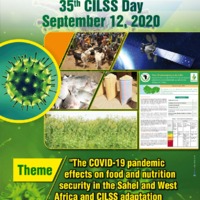Recherche
5 items
35th CILSS Day September 12, 2020
"The COVID-19 pandemic effects on food and nutrition security in the sahel and west Africa and CILSS adaptation efforts for information production"
Ensuring peaceful livestock mobility
Mobile livestock production in the Sahel and West Africa is a way of life and a form of adaptation and resilience developed over thousands of years by pastoralists and agro-pastoralists to cope with the effects of desertification and climate change, and to make the best use of the vast expanses of arid and semi-arid regions. This livestock farming system makes it possible to seek complementarities with the agro-ecological zones of the southern savannah regions through the use of pasture and water. In this way, livestock farming helps to provide substantial income for the local population and ensure food security. The N’Djamena symposium in the Republic of Chad (May 2013) and the Nouakchott declaration in the Islamic Republic of Mauritania (October 2013) gave renewed interest to the livestock sector with the implementation of several regional initiatives such as PRAPS, PREDIP, PEPISAO financed respectively by the World Bank, the European Union and the Agence Française de Développement and coordinated by CILSS as well as others such as PACBAO, MOPSS, etc.
Evaluation of the regulatory framework for pastoralism and cross border transhumance in West Africa and the Sahel
i) The Economic Community of West African States (ECOWAS) is a pioneer in establishing regulations for the exercise of cross-border transhumance, a somewhat controversial livestock production system in relation to its economic, social and environmental impacts, and the conflicts of access to natural resources that are sometimes associated with it.
ii) Since 1998, ECOWAS has been experimenting with a set of legal and technical instruments to provide a framework for the exercise of this multi-functional credited activity, which makes it a powerful means of strengthening the resilience of populations in general, and pastoralist and herder households in particular, on the one hand, and promoting social and regional integration in West Africa, on the other.
Products for capitalizing on experiences and acquired knowledge of PREDIP
CILSS has achieved significant results and a great deal of experience through the PREDIP implementation. A sample of eleven (11) major experiments and lessons learnt have been drawn up and documented using the “ongoing capitalisation» approach, with a view to building on these achievements for the benefit of stakeholders in the livestock and pastoralism sub-sector in the Sahel and West Africa. The experiments cover all the themes addressed by PREDIP (i.e., regional pastoral information service, dialogue and governance on cross-border transhumance, agro-pastoral infrastructures and facilities, animal health). Each of the fact sheets documenting these experiments includes a short summary giving the reader an overview of the content of the experiment and enabling him or her to extract the information he or she needs. In addition to these eleven (11) sheets, two (2) capitalisation notes have been produced. These experiments and capitalisation notes can be scaled up for greater value. They complement the existing body of knowledge on the promotion of the livestock sub-sector. For more detailed information, the reader is kindly invited to read the full report entitled: «Experience gained and lessons learnt from PREDIP implementation».
Special Bulletin of the 2024 Seasonal forecasts of the Agro-Hydro-Climate characteristics for the Sahelian and Sudanian zones of West Africa and the Sahel PRESASS 2024
The 2024 Edition of the PRESASS was organized from April 22 to 26, 2024 in Abuja, Nigeria, by AGRHYMET Regional Climate Center for West Africa and the Sahem (AGRHYMET RCC-WAS) of the CILSS, in collaboration with ACMAD, the National Meteorological and Hydrological Services (NMHSs), WMO and the West African River Basin Organizations.
.......Generally a wet rainy season is expected in 2024 over the Sahelian belt, with late to normal starting dates of the agricultural season in the Sahel-Central and early to normal s in the Sahel-West and East; late to normal ending dates of the agricultural season; short dry spells at the beginning of the season in the Sahel-West and medium to long dry spells in the Sahel-East and generally long dry spells towards the end of the season over the entire Sahelian belt; and above-average runoff in the main Sahelian river basins.......

